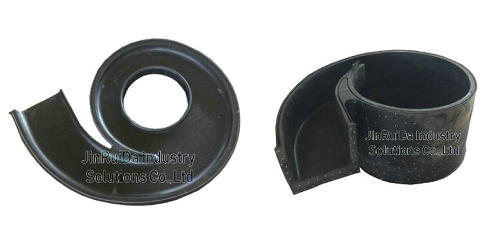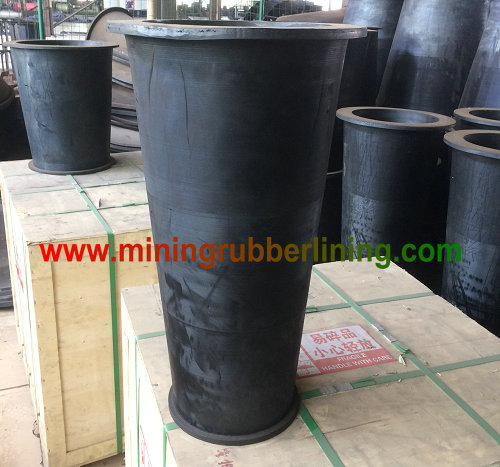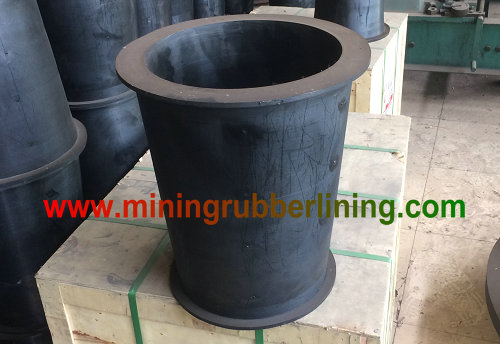Hydrocyclone Spigot Is Located At The Bottom Of The Whole Hydrocyclone, Which Is Responsible For Discharging Coarse Particles And Heavy Media. According To The Overall Structure Design Of The Cyclone, The Inlet Aperture Is Larger Than The Outlet Aperture, And The Spigot Also Faces Continuous High Pressure Wear. Therefore, The Wear Resistance Of This Part Is Very Important For The Service Life Of The Whole Hydrocyclone.
Spigot Parts Are Often Not Pure Metal Materials, But Lined With High Wear-Resistant Materials, Thus Ensuring That The Spigot Parts Of The Cyclone Can Withstand Stronger Wear And Tear. The Most Common Wear-Resistant Materials In The Industry Are Wear-Resistant Rubber, Polyurethane And Silicon Carbide.
The Advantages Of This Rubber Spigot Produced By Our Company Are Very Obvious. It Does Not Need To Be Pasted Directly Into The Inside Of The Hydrocyclone Like Polyurethane Spigot. It Only Needs Bolts To Be Tightened. It Is Very Easy To Install, Disassemble And Replace. It Has Better Sealing Effect Than Silicon Carbide Spigot. So Rubber Spigot Is Not Necessarily The Best Choice, But It Is The Most Widely Used Hydrocyclone Spigot In Major Mines At Home And Abroad.
Rubber Spigot Is Made Of Wear Resistant Vulcanized Rubber Pressed Through Metal Mold. Vulcanized Rubber Refers To Vulcanized Rubber, With The Same Sticky, Not Easy To Break And Other Characteristics. Spigot Are Mostly Made Of This Rubber. Also Called Cooked Rubber, Commonly Known As Rubber.
Rubber Material After Vulcanization Processing Of The General Name. a Spatial Stereoscopic Structure Is Formed Inside The Vulcanized Raw Rubber, Which Has High Elasticity, Heat Resistance, Tensile Strength And Insolubility In Organic Solvents. Rubber Spigot Mostly Vulcanized Rubber.
Rubber Is Heated To Become Soft, Not As Expected To Become Hard, Brittle, Not Easy To Form, Easy To Wear, Easy To Dissolve In Gasoline And Other Organic Solvents, The Molecule Has Double Bonds, Easy To Start Addition Reaction, Easy To Aging.
For Improving The Performance Of The Rubber Spigot, a Series Of Processing Processes Should Be Carried Out On The Production Of Raw Rubber. Under Certain Conditions, The Raw Rubber In The Rubber Can React With The Vulcanizing Agent, So That It Can Be Cross-Linked From Linear Macro Molecules To Solid Reticular Macro Molecules, So That The Rubber Materials Have High Strength, High Elasticity, High Wear Resistance, Corrosion Resistance And Other Excellent Properties. This Process Is Called Rubber Vulcanization.
Vulcanization Is The Basic Process Of Rubber Spigot Materials To Form Three-Dimensional Network Structure Through Inter Molecular Cross-Linking Of Raw Rubber To Prepare Vulcanized Rubber. Different Vulcanization Systems Are Suitable For Different Raw Rubber. a Composite Made Of Rubber (Raw Rubber) With a Variety Of Auxiliary Materials ,(The Auxiliary Material Has Several Systems, Filling Reinforcement, Vulcanization, Protection, Corrosion, Special Material Additives,) And Vulcanization Is a Treatment Method After Coating The Insulating Layer Or Sheath Layer, The Purpose Of Which Is To Make The Vulcanization System In The Auxiliary System Work, So That The Rubber Can Be Permanently Cross-Linked, Increase Elasticity And Reduce Plasticity. Vulcanization Is The Earliest Use Of Sulfur To Cross-Link Rubber So Called Vulcanization, Used Today.
Generally, The Rubber Spigot Vulcanization Process Is Divided Into Four Stages, Induction Pre Sulfur Positive Sulfur. In Order To Achieve This Reaction, It Is Necessary To Add Energy To Reach a Certain Vulcanization Temperature, And Then Let The Rubber Heat Preservation In This Vulcanization Temperature Range To Complete The Full Vulcanization Reaction.
As The Raw Material Rubber Of Vulcanized Rubber, It Can Only Be Cross Linked With Sulfur Or Peroxide.







Contact: Sales Department
Phone: +86 138 10365943
Tel: +86 166 33372827
Email: sales@miningrubberlining.com
Add: No.910 Zhongshan West Road Qiaoxi District Shijiazhuang Hebei China